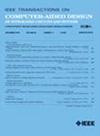基于通道的微流控装置中物质浓度模拟
IF 2.9
3区 计算机科学
Q2 COMPUTER SCIENCE, HARDWARE & ARCHITECTURE
IEEE Transactions on Computer-Aided Design of Integrated Circuits and Systems
Pub Date : 2025-03-10
DOI:10.1109/TCAD.2025.3549703
引用次数: 0
摘要
微流体器件的设计,即芯片实验室(loc)或微全分析系统($\mu $ TASs),是一个冗长而繁琐的过程,具有许多耗时和昂贵的制造周期。许多这些装置含有溶解物质(即溶质),这些物质需要以特定的预定义浓度出现在系统中。模拟的应用有助于微流控器件的设计过程。然而,通常使用的计算流体动力学(cfd)方法计算成本高,并且需要大量时间才能完成。在这项工作中,我们提出了一个基于通道的微流体装置的物种浓度模拟器,该模拟器在更高的抽象水平上运行,并且比CFD模拟方法快多个数量级。该模拟器已在c++中实现,并与CFD模拟以及在制造设备上的实验测量结果进行了基准测试。对仿真结果进行了分析,并评价了该仿真器在微流控器件仿真中的适用性。本文章由计算机程序翻译,如有差异,请以英文原文为准。
An Abstract Simulator for Species Concentrations in Channel-Based Microfluidic Devices
The design of microfluidic devices, i.e., Lab-on-Chips (LoCs) or Micro Total Analysis Systems ( $\mu $ TASs), is a tedious and cumbersome process with many time-consuming and costly fabrication cycles. Many of these devices contain dissolved species (i.e., solutes) that are required to appear in the system at specific predefined concentrations. The use of simulations can aid the design process of microfluidic devices. However, methods from Computational Fluid Dynamics (CFDs), which are commonly used, are computationally costly and require a lot of time to finish. In this work, we present a simulator for species concentrations in channel-based microfluidic devices that operates on a higher level of abstraction and is multiple orders of magnitude faster than CFD simulation methods. The simulator has been implemented in C++ and is benchmarked against CFD simulations as well as against measured results from experiments on a fabricated device. The results are analyzed and the applicability of the simulator for the simulation of microfluidic devices is assessed.
求助全文
通过发布文献求助,成功后即可免费获取论文全文。
去求助
来源期刊
CiteScore
5.60
自引率
13.80%
发文量
500
审稿时长
7 months
期刊介绍:
The purpose of this Transactions is to publish papers of interest to individuals in the area of computer-aided design of integrated circuits and systems composed of analog, digital, mixed-signal, optical, or microwave components. The aids include methods, models, algorithms, and man-machine interfaces for system-level, physical and logical design including: planning, synthesis, partitioning, modeling, simulation, layout, verification, testing, hardware-software co-design and documentation of integrated circuit and system designs of all complexities. Design tools and techniques for evaluating and designing integrated circuits and systems for metrics such as performance, power, reliability, testability, and security are a focus.

 求助内容:
求助内容: 应助结果提醒方式:
应助结果提醒方式:


